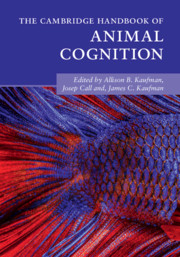Book contents
- The Cambridge Handbook of Animal Cognition
- The Cambridge Handbook of Animal Cognition
- Copyright page
- Dedication
- Contents
- Figures, Tables, and Boxes
- Contributors
- Acknowledgments
- Introduction
- Part I Communication and Language
- Part II Memory and Recall
- Part III Social Cognition
- Part IV Social Learning and Teaching
- Part V Numerical and Quantitative Abilities
- 24 Numerical and Quantitative Abilities Overview
- 25 Numerical Competence in Fish
- 26 Spatial–Numerical Association in Nonhuman Animals
- 27 Perceptual Categorization in Pigeons
- Part VI Innovation and Problem-Solving
- Index
- References
25 - Numerical Competence in Fish
from Part V - Numerical and Quantitative Abilities
Published online by Cambridge University Press: 01 July 2021
- The Cambridge Handbook of Animal Cognition
- The Cambridge Handbook of Animal Cognition
- Copyright page
- Dedication
- Contents
- Figures, Tables, and Boxes
- Contributors
- Acknowledgments
- Introduction
- Part I Communication and Language
- Part II Memory and Recall
- Part III Social Cognition
- Part IV Social Learning and Teaching
- Part V Numerical and Quantitative Abilities
- 24 Numerical and Quantitative Abilities Overview
- 25 Numerical Competence in Fish
- 26 Spatial–Numerical Association in Nonhuman Animals
- 27 Perceptual Categorization in Pigeons
- Part VI Innovation and Problem-Solving
- Index
- References
Summary
Although fish represent approximately half of vertebrates, the quantitative abilities of fish have been investigated only recently. Two methodological approaches commonly used with mammals and birds have been used: the observation of spontaneous behaviour and training procedures. In the former, fish are observed in their preference for reaching the larger or smaller quantities of biologically relevant stimuli (in most cases, whether they join a larger shoal when placed in an unfamiliar environment). In the latter, fish are trained to select the larger or the smaller of two sets of abstract objects (e.g., two-dimensional figures that differ in numerosity). These studies showed that different fish species process numerical information in a similar way to that of mammals and birds. In this chapter, we review the relevant literature, giving particular regard to the strength and potential weaknesses of the two methodological approaches.
Keywords
- Type
- Chapter
- Information
- The Cambridge Handbook of Animal Cognition , pp. 580 - 601Publisher: Cambridge University PressPrint publication year: 2021
References
- 2
- Cited by

